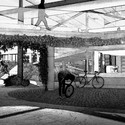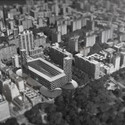architecture
a revolution occurs in the design of the street. New York, arguably the world city of the barometer, let the citizens of all days of the cycle for transport. They did so by designating a path on most Avenues just cyclists, with barriers to protect traffic.
Now hundreds of cities are some adjustments to be bicycle-friendly, while in New York there is a feeling that more change is in progress. Many New Yorkers prefer that their town was more like Copenhagen, where 40% of all trips are by bicycle. But then Copenhagen wants more as well. Where does this stop?
If we consider that we are talking about a mode of transport that whips our hearts shaped funnels a lot more people the streets that can be channeled in cars, not pollution, and cost governments and individuals an absolute misery, ask yourself the habit where it stops, but how close to 100% from bike modal can possibly go and what we must do to achieve it.



 12
12
the highest standards have been set by China where until a few decades ago, cycling accounted for about 80% of all trips in some cities. Mao Zedong could achieve by applying a collectivist vision. In democracies, we must find seductions. Most, I suggest, will come from the imagination of architects. This article is illustrated with a provocative design that I developed with Charlotte Morton, a symbolic site in Manhattan. The Frederick Douglass Houses are emblematic of the post WW2 attempt to transform New York into a city to drive when, as we know, it was built as a city for walking.
The site could be densified again with more lift access and walk-up apartments. In other words, it could be dragged back in time to the 1960s era of conduct at the time of the 1860s of walking. But if it could be dragged forward in time? What if you could see the architectural principles that would accompany a future age of the bicycle transportation? Here are ten ways to get there.
1. practical things to use in bicycles buildings
So many bike theft could be avoided if only we realized that bikes are not stained in manure. They may have been in the days of the horse, but these days wheelchairs and strollers go from the street into buildings and nobody minds. So why not take our bikes inside also?
Imagine the benefits of a parent. He or she would be able to run inside their apartment directly driveway cold food in the back of the supermarket. With a cargo bike, they could take their babies to sleep for the ride and use their bicycle as a trolley.
Or if the bike an office worker accompanying them as a briefcase? They could dock their bike to their office and their home office, then the table in the cafe where they like to check emails. Their pannier bag could lead as part of a mobile office.
2. Whether the bike is the fastest way to leave the house.
In residential buildings that have air streets leading down to the ground (like 8-BIG House in Copenhagen ) or a slope rises to cut the adits plans (as happens to apartments Park Hill in Sheffield) the fastest way on the floor of a high apartment can be on a bike. My next book, Velotopia, have ideas for the types of apartment blocks that push this idea even more difficult. Residential areas are designed as bike tanks, unload the maximum number of people on the street with their bikes.
3. Weather protection
Despite that some apologists for the transport of bikes could say, rain discourages many people bike to work or school. Whoever says bike path should be different from driving or taking the bus, not having a roof, had too much praise for riding to work in all weather conditions. Naturally, they are resistant design that would get the comfort cowardice cycle as well.
Ignore their little agenda! As architects, we must focus on protecting cyclists citizens of wind, sun and rain hard putting the bike on an equal footing with other modes any time.
4. Carve the field to control the speed of cyclists
in any place where bikes are expected to slow as a side road or activity node, runners can be saved braking hassle if, as designers we raise these points to the ground by one or two meters. People on bikes will slow down as they increase, then regain their speed as they plunge further.
5. Making peace between bikes and pedestrians
cars can be banned from our cities, or at least large tracts through them, but the people on bikes and pedestrians must make peace. Consider this then: that the blocks are well on the feet, but are terrible to climb, while a platform off-camber is not worth getting on, but would cause the ankles of a pedestrian to roll. Now you join the dots. Furthermore, making the point 4, high common areas can be linked with bridges, leaving low level forced severity zones, for faster cycling.
6. Assess cognitive maps of cycling in their cities
many drivers know what it's like to get to destinations across the parking lot in the basement linked by cross-city tunnels, while more than a subway user took two trains to get between points later they found were a few steps away. Those of us who are used to transport bicycles have yet another image of our city, often dominated by seafront and the railway corridor trails, and linear parks. Architects need to take the bike cognitive maps of the communities of their cities into account in the analysis of sites, planning links through the site, and determine where to place entries.
7. Cycling Dissolves dichotomy mobility / access
once we accept that the tool to transport people across cities in record time, can be pushed or even mounted inside the dichotomy we see in a city car between mobility and access is no longer applicable. arterial bike paths can double as platforms for trade.
8. dispersion shops
People stroll to 3-5 km / h and cycling 15-25 kilometers per hour. This means that in the bicycle oriented district stores can be five times more spatially separated, but no other if we measure in seconds. Rather than focusing along avenues activity, which always leaves the side streets without passive surveillance, storefronts can be dispersed.
9. mogul field concept
Some the foregoing principles, I mentioned dispersion shops, elevation shared spaces to help cyclists to slow down and throw the old distinctions between access and mobility links lead to an alternative to traditional street as a basis for planning of the city. The ground plane can become a field of large bumps. The adits helical ramp General buildings and entrances solitary stores that were uniformly dispersed in a large district, would be found on the ridges. Pedestrians can move between the ridges by the bridges and people on bikes could use the gravity zone forced lower. Bicycle paths at these lower levels can pass under the head blocks, leaving cyclists are beelines between any two points in the city.
10. cause with proposals
What is the real lesson of provocative visions as Plan Voisin Le Corbusier, or Broadacre City Frank Lloyd Wright? If we think it is that provocations are dangerous, we miss the real lesson of history is that provocations change. It was a bad thing in the 50s, when the new vision was to fill the cities with cars. The situation is different now that cities need fixing. There are opportunities, a vision of a city by bike, if it has captured the imagination of the public, would be a positive force for change.
The car-city paradigm has been introduced to New Yorkers in an exhibition entitled Futurama during their 1939 World Expo the idea was to make the tall and slender buildings so that, down at ground level, there would room for much more mobility routes for their mobility. All that resulted were tricks in a parking lot and residents to walk.
The proposal is to replace two rounds with a block that would double helix ramp adits serving each apartment. The bike path parallel to 97th Street Traverse through Central Park would be extended to meet the site. New bike off-road tracks reaching across the Frederick Douglass Houses website would attract people on Amsterdam Ave and bicycles blocks north of 104th Street. For a growing number of New Yorkers who have swapped walking, driving and transit for cycling on most occasions, the site would become a key gateway between wide cycling network from Central Park and the Upper West Side. Many cyclists could see it as the ideal place.
Dr. Steven Fleming is an academic at the University of Tasmania, Australia and author of Space Cycle , and the next book Velotopia , to be published by NAi010 Publishers in Rotterdam. He consults industry building professionals and government agencies on the construction for bicycles. Find him on the Web at cycle-space.com and follow him on Twitter @behoovingmoving
Posting Komentar